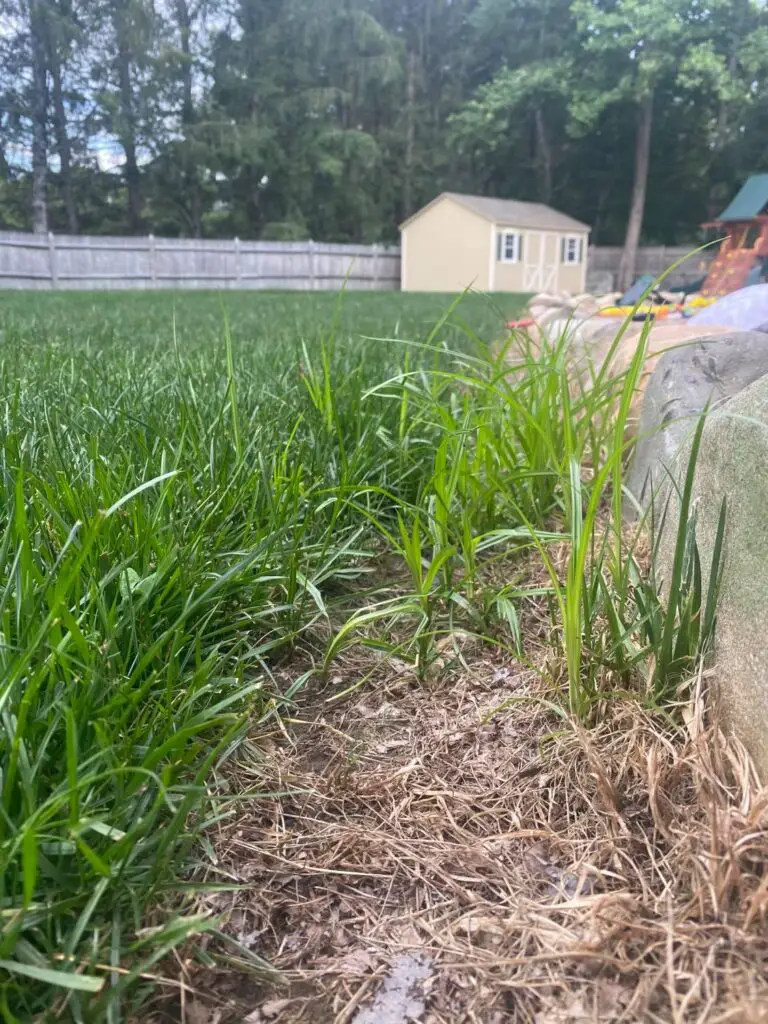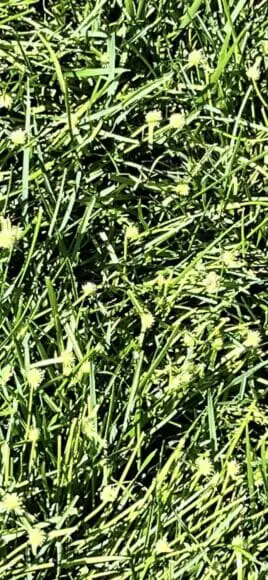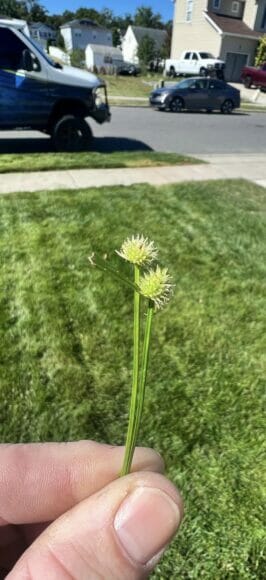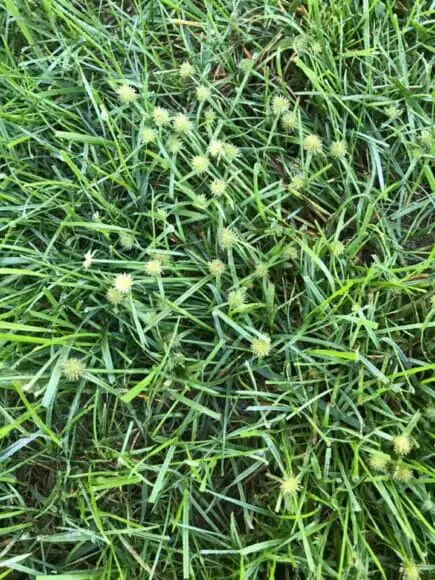Kyllinga, also popularly known as green kyllinga, and nutsedge are both perennial sedges that are native to Asia and have a reputation for spreading quickly. Both are also known to spread rapidly when conditions are wet and soil is poorly draining. Even so, there are notable differences between these two sedges that can help property owners manage them effectively.
Both species can invade turfgrass, but they can be eradicated with proper identification and control measures. Sedges like green kyllinga and nutsedge are aggressive and persistent when infiltrating turfgrass. Early identification and weed control measures are ideal for managing them effectively.
Both nutsedges and kyllinga are unique in that they aren’t broadleaf weeds or grassy weeds; they are weeds that you don’t want to invade your landscape and lawn.
What Is the Difference Between Green Kyllinga and Nutsedge?
Although green kyllinga and nutsedge are both sedge species, they differ. Kyllinga has finer blades than nutsedge. The leaves of both purple and yellow nutsedge are much wider than kyllinga blades. Kyllinga also has a small and round seed head. Nutsedge has an open spikelet as its seed head. Additionally, nutsedges have underground tubers, but kyllinga does not. Additionally, false green kyllinga (Kyllinga gracillima), which is similar to the species it’s named for, grows in mid-Atlantic states where it, too, is difficult to eradicate. You can suppress false green kyllinga with controls like killing other sedges invading healthy turf.
What Is Nutsedge?
Purple or yellow nutsedge are commonly referred to as nutsedge. Both occur in lawns and, once there, are tough to eradicate from turfgrass. Nutsedge thrives in warm and wet conditions. Although nutsedge is a problem for Florida property owners all year long, it tends to confine itself to being a spring and summer nuisance in other southern states.
Purple and yellow nutsedge refer to the colors of the plants’ flowers. Both these types of nutsedges grow extensive root systems and appear to grow in ‘colonies’ as they spread so quickly. You can identify nutsedges by their v-shaped blades (grass blades have three points or a triangular stem) and by their horizontal growth patterns as they form new plants via their rhizomes. Also, nutsedge plants have ‘edges’ that you can feel when rolling the blade between two fingers. Their blades are much stiffer than grass blades.



What Is Green Kyllinga?
Green kyllinga (Kyllinga brevifolia), a perennial plant, (and false green kyllinga) has grass-like leaves but grows in thick mats. The species can survive with some shade but prefers full sun. It can reach a height of about 15 inches and tends to thrive between the months of April and October. It’s often easy to spot green kyllinga because of its outward growth pattern; in other words, its patch continues to expand until you put kyllinga control methods in place.
You can also identify green kyllinga by its flower stalk that produces a green globular flower head between May and October. Each flower that emerges from a stalk has about 30-70 spikelets that can produce about 5,000 seeds each. That means that green kyllinga (and false green kyllinga) can grow from seed or its rhizomes each growing season. Because green kyllinga grows more quickly than most species of turfgrass, it’s easy to spot.
Sometimes people reference false green kyllinga. This sedge is extremely similar to green kyllinga. However, false green kyllinga grows in mid-Atlantic states. Green kyllinga grows only in southern states. False green kyllinga control involves methods similar to other types of sedge control like yellow and purple nutsedge. False green kyllinga can produce numerous underground stems like the species it’s named for, which makes it challenging to eradicate in cool season turfgrass species.



Cultural Control of Green Kyllinga and Nutsedge Plants
To prevent new infestations of green, false green kyllinga, and nutsedge in other areas of your lawn, it’s important to clean your lawn mower after mowing sections of green kyllinga (and false green kyllinga) and nutsedge weeds in addition to making herbicide applications. Since both green kyllinga and nutsedge thrive in poor draining soil and wet conditions, it’s helpful to reduce watering if these weeds are present. Avoid leaving open spots in your lawn where weeds can easily root. Maintaining a healthy lawn at your home or golf course is key to warding off weeds like nutsedge and green kyllinga. Physical removal of the plants is unlikely to stop it’s spread, especially since sedge seeds like kyllinga seed can remain viable in the soil. Using chemicals is best for long term kyllinga control once it’s established itself in your warm season turf.
Chemical Control of Green Kyllinga and Purple or Yellow Nutsedge
For small invasions of the green kyllinga species and purple or yellow nutsedge in warm season turf, some gardeners will spray glyphosate; however, this chemical will kill healthy grass too, so it’s important to spray only the weed you want to kill.
For a list of selective herbicides that are safe for warm and cool grasses – including Halosulfuron-methyl, Sulfentrazone, and Mesotrione – refer to the best nutsedge killers.
Because of both weeds’ tenacious growth habits, you may also want to spray pre- and post-emergent herbicides (after nutsedge and kyllinga shoots appear). When using post-emergent herbicides, spray before the plants produce their flowers and seeds. Time your herbicide applications on the soil surface to ensure best results. You can chemically control sedges like yellow nutsedge and green kyllinga with adequate control measures.
False green kyllinga control mirrors the methods used to control kyllinga growing in the south. Remember that the multiple applications of herbicides are generally necessary for a severe infestation of sedge family species. Using applications of both pre- and post-emergent herbicides can provide adequate control for mild infestations.
Selective Herbicide Options
When choosing a pre-emergent herbicide to kill green kyllinga and nutsedge weeds on the soil surface, consider using prodiamine or dithiopyr. Pendimethalin will also work well. When choosing a post-emergent herbicide, you can try MSMA, halosulfuron, or trifloxysulfuron. Be sure to select herbicides that are safe for the type of lawn you’re growing.
Generally, the best way to control nutsedge and kyllinga is to use both a pre-emergent herbicide and a post-emergent herbicide. Plan herbicide programs carefully so that you can coordinate their use. Herbicide residual concerns might impact your plans for desirable turfgrass management. Still, many chemicals can help you successfully control green kyllinga and nutsedge while not harming your warm or cool season grass.
Nutsedge vs Green Kyllinga FAQs
What is false green kyllinga?
False green kyllinga (Kyllinga gracillima) is a perennial sedge that’s similar to the green kyllinga species and belong to the same plant family. However, green kyllinga grows only in southern states; false green kyllinga grows in turfgrass species of mid-Atlantic states.
How do I get rid of Kyllinga grass?
You can eliminate kyllinga grass by maintaining a healthy lawn and not overwatering it. You can apply pre-emergent herbicides and post-emergent herbicides to control these weeds. Adjust irrigation systems to ensure you don’t overwater your landscape or golf course. Physical removal of green kyllinga and false green kyllinga rhizomes is not always possible, so herbicide control methods are generally best. Always choose herbicides that are right for your turfgrass species.
What does kyllinga look like?
Kyllinga has dark green leaves and grows in dense mats. The edges of its leaves have small barbs. It produces green flowers. It forms a dense turf-like mat in soils with poor drainage.
Are sedges and kyllinga the same?
Kyllinga is a sedge plant. Sedges have many features in common, but kyllinga is just one of many sedge plants. False green kyllinga affects cool season turf while nutsedge and green kyllinga affect southern lawns.
